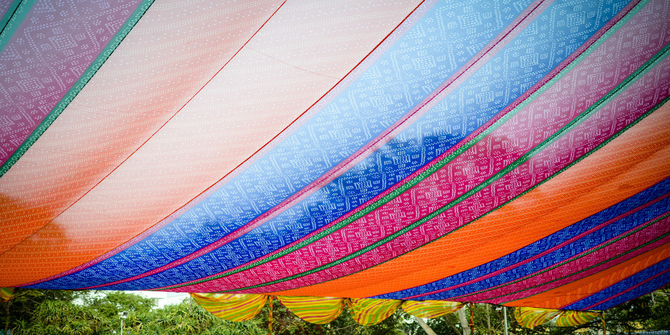Now in its twelfth year, the ZEE Jaipur Literature Festival gathers leading writers of both fiction and non-fiction from around the world for a weekend of debate and reflection. On the festival’s second day, South Asia @ LSE blogger Tom Wilkinson listened to a panel discussion on the unity and divisions across South Asia. Read what he found this year’s participants at Jaipur discussing.
 Photo: Decoration at Jaipur Literary Festive | Credit: Flickr, Creative Commons
Photo: Decoration at Jaipur Literary Festive | Credit: Flickr, Creative Commons
“Is there anyone here who has visited all of the South Asian countries?” This was the question Suhasini Haidar, moderator of South Asia: Walls and Bridges, asked a full house on the main stage at the Jaipur Literature Festival 2019 during a discussion on the unity, commonality and divisions of region. In response, just a handful of arms were raised. The silence that crept across the otherwise bustling (and well-travelled) crowd spoke volumes about how interconnected – or not interconnected – the region is in 2019. In reality, travel between South Asian countries is limited, and people-to-people contact across the region is surprisingly uncommon; one can’t travel from Karachi to Kathmandu without flying via Dubai, for example. In the post-colonial era, the concept of South Asia – the idea of an essential unity across the sub-continent – has gained much traction, however that traction has faced a considerable set of obstacles.
“The South Asian Association for Regional Cooperation (SAARC) as a concept has failed. It has disappointed even its greatest proponents,” declared Suhasini Haidar, Diplomatic Editor of the Hindu. The efforts to achieve greater co-operation that gave rise to SAARC have indeed seemingly stalled. In 2014, India, Bangladesh, Afghanistan and Bhutan all said they would quit SAARC following the rising hostility between Pakistan and India. The organisation has no plans to meet again. Moreover, there is little in the way of realising its economic agenda on the scale intended or increasing regional inter-connectively.
Prasenjit Basu, Author of Asia Reborn, was quick to dismiss the idea of a pan-South Asia unity. Take the idea of the London curry-house, he asked of the audience. “It’s simply known as ‘The Indian’” despite such restaurants working under the ownership of Bangladeshi or Pakistani immigrants. Basu’s Indian-centric approach to the region received a warm round of applause.
“If you call it the Indian sub-continent then you put everyone off, it’s as if you own it…it’s the most threatening thing you can say”, Shivshankar Menon, Diplomat and Author of Choices: Inside the Making of Indian Foreign Policy interjected. The looming Indian presence makes its neighbouring states new kids on the block in the Westphalian sense understand subcontinental integration with suspicion. Nepali journalist Manjushree Thapa reiterated such a concern. “The Indian-centred imagination, which sees itself as the centre and everything else as the periphery, fuels an anti-Indian sentiment”.
But what about the bridges? Despite the political barriers to efforts to create deeper cooperation in South Asia, there also exists profound economic connections. “The walls are political, but the bridges are everything with else”, Menon argued. Take the border between Nepal and India. It’s irrelevant, he argued as there is an unprecedented flow of people into India. Or take remittances that flow between India and Bangladesh. Then there’s the 1997 India-Sri Lanka free trade agreement that has significantly bolstered economic ties. Therefore these are a series of important connections between countries that, the panel argued, the official World Bank figures fail to reflect. The World Bank’s current figure of economic activity within the region stands at a lowly six percent, although this fails to account for the widespread informal trade methods and
The outlier to this South Asian integration is Pakistan, and it is potentially the India-Pakistan relationship that prevents SAARC from fulfilling it real potential. As the discussion pivoted towards this conflict, Pakistan author, Husain Haqqani, put forward an idea of a South Asian identity that is less binary than the post-colonial territorial divisions suggest. To the audience, Haqqani said he felt “Pakistani by citizenship, Indian by civilization…This is a region that has five thousand years of commonality and shared history, and a few years of partition.” For Haqqani the cultural similarities between the countries are stronger than the recent divisions.
From discussions such as this at Jaipur, one cannot help but think that the debate about South Asia goes back to a debate that has raged across this region: Do religious identities and other such cleavages prevent a pan-South Asian identity? This panel certainly does not think so. “There is a common bond…There is no part of South Asia that doesn’t share some language, some religion, some culture, some food, some favourite cartoon character with another part of South Asia”, Suhasini Haidar, the panel’s moderator, said. The panel appeared to agree that the affinities and similarities between ordinary people were stronger than the state-level divisions.
But what of the world of words and literature? There is currently only one magazine that is concerned with the affairs of South Asia: Himal. On the magazine’s front page there is a map that stretches from the Maldives to Tibet (rather than the other way around) and is seemingly upside down. This rotation challenges the conceptualisation of the north as ‘top’ of the region, offering a refreshing way to imagine the subcontinent. It is this type of blue sky thinking that novel conceptualisations of the subcontinent need.
Perhaps what’s most striking from this panel is the dominance of a view, from the Indian panellists in particular, that metaphorises South Asia as an India-centred family. This perspective places Pakistan as the once deeply close but now estranged brother; Nepal as the chhota bhai and Bhutan the (endearing) sabse chota bhai; Bangladesh as the half-brother and Sri-Lanka as a half-sister; Afghanistan is the distant relation who looks more to its West Asian (rather than Indic) roots; Burma who prefers it’s South- East Asia relations, and the Maldives is the cousin that does its own thing. Within this idea, India is the strong and paternalistic uncle. This understanding of South Asia as a kind of ‘Greater India’, however, needs to be scrapped. This nation-state centred discourse has prevailed for seven decades, but it is think to rethink how best to shrink perceived distances in an alternative manner. It is time to reimage South Asia.
This article gives the views of the author, and not the position of the South Asia @ LSE blog, nor of the London School of Economics. Please read our comments policy before posting.
Tom Wilkinson (@tomwilk0) is a PhD candidate in the Department of International History at the LSE. Tom is currently based in New Delhi and is a visiting research scholar at Jawaharlal Nehru University. His doctoral research investigates conceptions of youth in the colonial and early post-colonial India. Prior to commencing his doctoral research, he worked as a Parliamentary Assistant in Westminster and as a teaching assistant in Delhi for the British Council.








Hi! I really liked your piece on the state of the pan-South Asian unity. I agree with the similarities and yet there being all kinds of walls between the many countries of South Asia. But I think it is imperative that we understand the deeply rooted alienation and estrangement Indians in general have when it comes to the people from other South Asian countries.
While I think people do consider nepal as the ‘chota bhai’ and Bangladesh as the ‘half brother’, I have personally experienced through volunteering that they don’t seem to have any sense of solidarity with them mostly due to the tragic state of affairs of their own community. As selfish as it sounds, I have observed people making the case about caring for their ‘own’ people first rather than extending out a friendly hand towards their brothers from neighbouring countries. Add to that the appeal and aesthetic of places like Maldives being reduced to a ‘honeymoon destination’ or a rich in culture tourist spot by both western and Indian folks, these places and their communities are then boxed in multiple racial stereotypes. Finally, the barometer for the people from the so-called ‘fastest growing economy’ still seems to be the scientific and societal development in the Western countries. And with more and more Indian leaders becoming a part of something like the silicon valley, there does seem to be a superiority complex amongst Indians for playing a pivotal role in setting that standard and thus perpetuating the chest beating narrative (especially between India and Pakistan) and an India-centered family approach.
As a research scholar who has the privilege of sharing and collaborating with fellow South Asians in scientific research and academia, I feel that these uncomfortable points need to be addressed when discussing the relations and the lack of person to person contact in South Asia.
Thank you for reading such a long post.